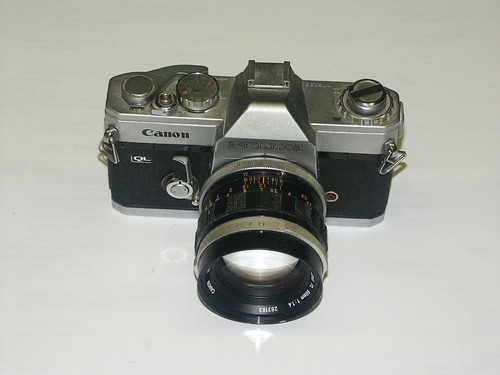Difference between revisions of "Canon Pellix"
m (→Description: categories) |
(contrib) |
||
| Line 2: | Line 2: | ||
<div class="floatleft plainlinks">[http://www.flickr.com/photos/jimmysmith/81577593/in/pool-camerapedia http://farm1.static.flickr.com/41/81577593_de781aaffe.jpg]</div>{{br}} | <div class="floatleft plainlinks">[http://www.flickr.com/photos/jimmysmith/81577593/in/pool-camerapedia http://farm1.static.flickr.com/41/81577593_de781aaffe.jpg]</div>{{br}} | ||
| − | The [[Canon]] '''Pellix''', | + | The [[Canon]] '''Pellix''', launched in 1965, is a rather unique manual focus [[SLR]]. It was Canon Camera Company's first 35mm focal-plane shutter SLR camera with [[TTL]] metering. However, what makes it special is the reflex mirror. The traditional moving [[SLR]] mirror is replaced by a fixed semitransparent [[pellicle]] mirror splitting the light rays from the lens into about 2/3 hitting the film, and the rest being reflected to the viewfinder. The object of this arrangement is for a simpler construction, a less noisy operation, and no finder blackout. |
| + | |||
| + | The meter cell is placed on a moving arm, which is swung-out in front of the film using the large self-timer lever on the camera front. Pushing the lever towards the lens activates the stop down match-needle meter, while pulling in the opposite direction winds the timer. In order to prevent light, under unfavourable conditions, entering through the finder hitting the film during exposure, a blind is provided. It is operated by a knob surrounding the rewind knob, marked ''CLOSE - OPEN''. The meter battery compartment is situated at the left-hand side of the camera, just next to the rewind knob. The rewind release is at the camera base, as is the back opening key. The shutter has a locking device combined with its collar, marked ''A'' and ''L''. | ||
| + | |||
| + | A year after its introduction, the camera was equipped with the QL feature, making film loading much easier, - identified by a small ''QL'' badge on the front, for Quick Load. After many years, most of these cameras would be rendered useless. The reason being a defective meter circuit and a stained or torn mirror, the latter being extremely vulnerable, and almost certainly not clear and spotless. The camera is however highly collectible. | ||
| + | |||
| + | The standard lens for the Pellix is the fast Canon Lens FL58mm 1:1.2 with automatic aperture diaphragm operation, popular since the extra light it lets through compensates for the loss of light due to the pellicle mirror. | ||
<br clear="all"/> | <br clear="all"/> | ||
Revision as of 07:07, 15 June 2009
Description
The Canon Pellix, launched in 1965, is a rather unique manual focus SLR. It was Canon Camera Company's first 35mm focal-plane shutter SLR camera with TTL metering. However, what makes it special is the reflex mirror. The traditional moving SLR mirror is replaced by a fixed semitransparent pellicle mirror splitting the light rays from the lens into about 2/3 hitting the film, and the rest being reflected to the viewfinder. The object of this arrangement is for a simpler construction, a less noisy operation, and no finder blackout.
The meter cell is placed on a moving arm, which is swung-out in front of the film using the large self-timer lever on the camera front. Pushing the lever towards the lens activates the stop down match-needle meter, while pulling in the opposite direction winds the timer. In order to prevent light, under unfavourable conditions, entering through the finder hitting the film during exposure, a blind is provided. It is operated by a knob surrounding the rewind knob, marked CLOSE - OPEN. The meter battery compartment is situated at the left-hand side of the camera, just next to the rewind knob. The rewind release is at the camera base, as is the back opening key. The shutter has a locking device combined with its collar, marked A and L.
A year after its introduction, the camera was equipped with the QL feature, making film loading much easier, - identified by a small QL badge on the front, for Quick Load. After many years, most of these cameras would be rendered useless. The reason being a defective meter circuit and a stained or torn mirror, the latter being extremely vulnerable, and almost certainly not clear and spotless. The camera is however highly collectible.
The standard lens for the Pellix is the fast Canon Lens FL58mm 1:1.2 with automatic aperture diaphragm operation, popular since the extra light it lets through compensates for the loss of light due to the pellicle mirror.
Links
- Photoethnography's Pellix page
- Canon Pellix Cameras at Photography in Malaysia
- Canon Pellix on www.collection-appareils.fr by Sylvain Halgand
- User manual in french for Pellix on www.collection-appareils.fr by Sylvain Halgand
